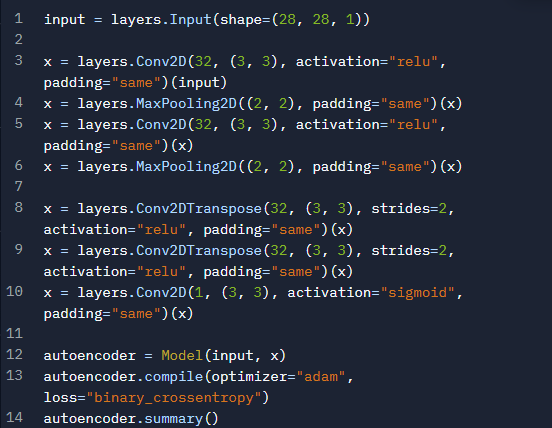1 input = layers. Input (shape=(28, 28, 1)) 2 3 X = layers. Conv2D(32, (3, 3), activation="relu", padding="same") (input) 4 5 x = layers.MaxPooling2D((2, 2), padding="same") (x) X = layers. Conv2D(32, (3, 3), activation="relu", padding="same") (x) 6 X = layers. MaxPooling2D((2, 2), padding="same") (x) 7 8 x = layers. Conv2DTranspose (32, (3, 3), strides=2, activation="relu", padding="same") (x) 9 X = layers. Conv2DTranspose (32, (3, 3), strides=2, activation="relu", padding="same") (x) Le X = layers. Conv2D(1, (3, 3), activation="sigmoid", padding="same") (x) 11 12 autoencoder = Model (input, x) 13 autoencoder.compile(optimizer="adam", loss="binary_crossentropy") 14 autoencoder.summary() W NH
1 input = layers. Input (shape=(28, 28, 1)) 2 3 X = layers. Conv2D(32, (3, 3), activation="relu", padding="same") (input) 4 5 x = layers.MaxPooling2D((2, 2), padding="same") (x) X = layers. Conv2D(32, (3, 3), activation="relu", padding="same") (x) 6 X = layers. MaxPooling2D((2, 2), padding="same") (x) 7 8 x = layers. Conv2DTranspose (32, (3, 3), strides=2, activation="relu", padding="same") (x) 9 X = layers. Conv2DTranspose (32, (3, 3), strides=2, activation="relu", padding="same") (x) Le X = layers. Conv2D(1, (3, 3), activation="sigmoid", padding="same") (x) 11 12 autoencoder = Model (input, x) 13 autoencoder.compile(optimizer="adam", loss="binary_crossentropy") 14 autoencoder.summary() W NH
Computer Networking: A Top-Down Approach (7th Edition)
7th Edition
ISBN:9780133594140
Author:James Kurose, Keith Ross
Publisher:James Kurose, Keith Ross
Chapter1: Computer Networks And The Internet
Section: Chapter Questions
Problem R1RQ: What is the difference between a host and an end system? List several different types of end...
Related questions
Question
- Explain the following code

Transcribed Image Text:1
input = layers. Input (shape=(28, 28, 1))
2
3
X = layers. Conv2D(32, (3, 3), activation="relu",
padding="same") (input)
4
5
X = layers.MaxPooling2D((2, 2), padding="same") (x)
X = layers. Conv2D(32, (3, 3), activation="relu",
padding="same") (x)
6
X = layers. MaxPooling2D((2, 2), padding="same") (x)
7
8
X = layers. Conv2DTranspose (32, (3, 3), strides=2,
activation="relu", padding="same") (x)
9
X = layers. Conv2DTranspose (32, (3, 3), strides=2,
activation="relu", padding="same") (x)
10
X = layers. Conv2D(1, (3, 3), activation="sigmoid",
padding="same") (x)
11
12 autoencoder= Model (input, x)
13 autoencoder.compile (optimizer="adam",
loss="binary_crossentropy")
14 autoencoder.summary()
Expert Solution
This question has been solved!
Explore an expertly crafted, step-by-step solution for a thorough understanding of key concepts.
Step by step
Solved in 2 steps

Recommended textbooks for you

Computer Networking: A Top-Down Approach (7th Edi…
Computer Engineering
ISBN:
9780133594140
Author:
James Kurose, Keith Ross
Publisher:
PEARSON

Computer Organization and Design MIPS Edition, Fi…
Computer Engineering
ISBN:
9780124077263
Author:
David A. Patterson, John L. Hennessy
Publisher:
Elsevier Science

Network+ Guide to Networks (MindTap Course List)
Computer Engineering
ISBN:
9781337569330
Author:
Jill West, Tamara Dean, Jean Andrews
Publisher:
Cengage Learning

Computer Networking: A Top-Down Approach (7th Edi…
Computer Engineering
ISBN:
9780133594140
Author:
James Kurose, Keith Ross
Publisher:
PEARSON

Computer Organization and Design MIPS Edition, Fi…
Computer Engineering
ISBN:
9780124077263
Author:
David A. Patterson, John L. Hennessy
Publisher:
Elsevier Science

Network+ Guide to Networks (MindTap Course List)
Computer Engineering
ISBN:
9781337569330
Author:
Jill West, Tamara Dean, Jean Andrews
Publisher:
Cengage Learning

Concepts of Database Management
Computer Engineering
ISBN:
9781337093422
Author:
Joy L. Starks, Philip J. Pratt, Mary Z. Last
Publisher:
Cengage Learning

Prelude to Programming
Computer Engineering
ISBN:
9780133750423
Author:
VENIT, Stewart
Publisher:
Pearson Education

Sc Business Data Communications and Networking, T…
Computer Engineering
ISBN:
9781119368830
Author:
FITZGERALD
Publisher:
WILEY